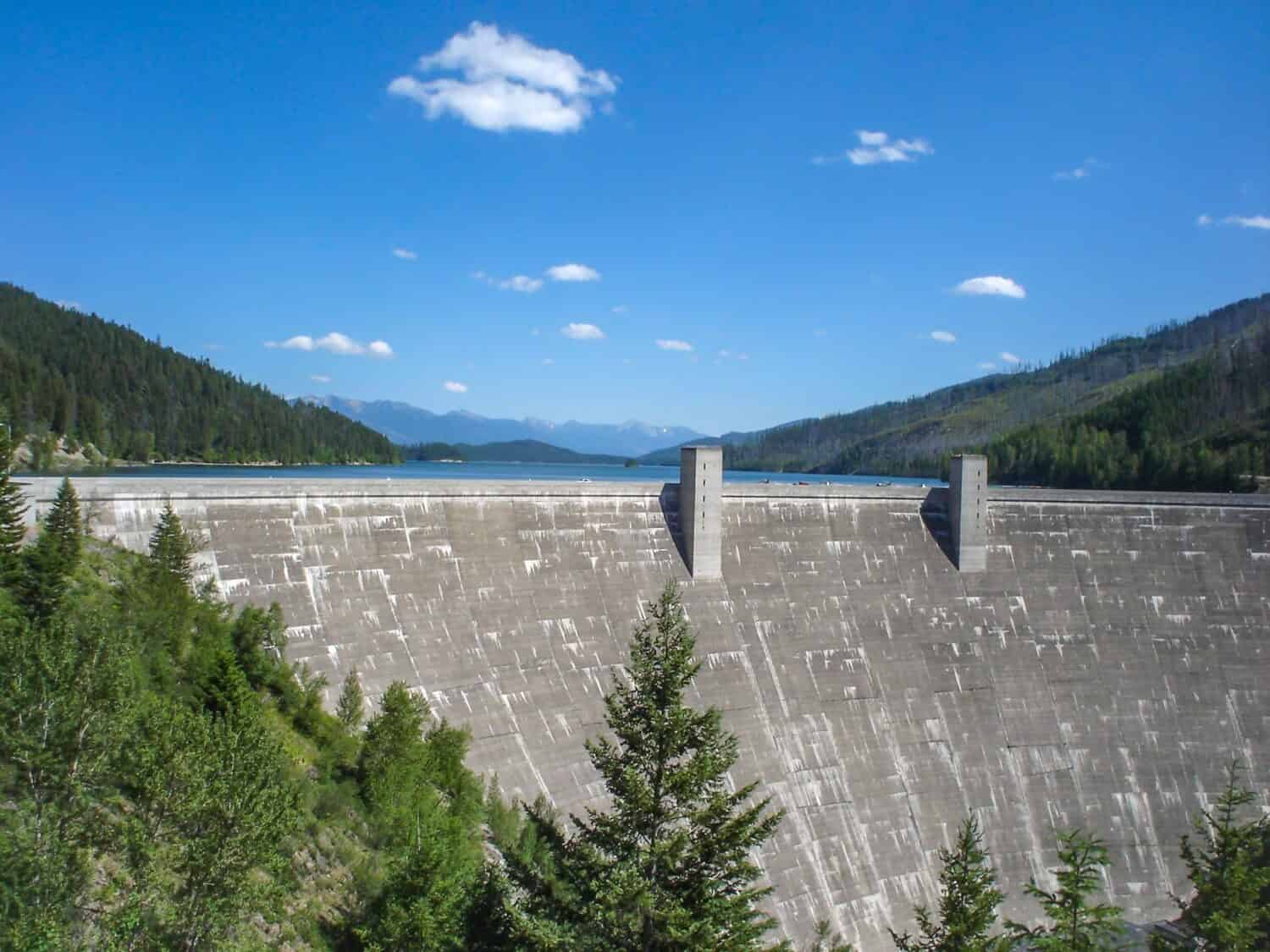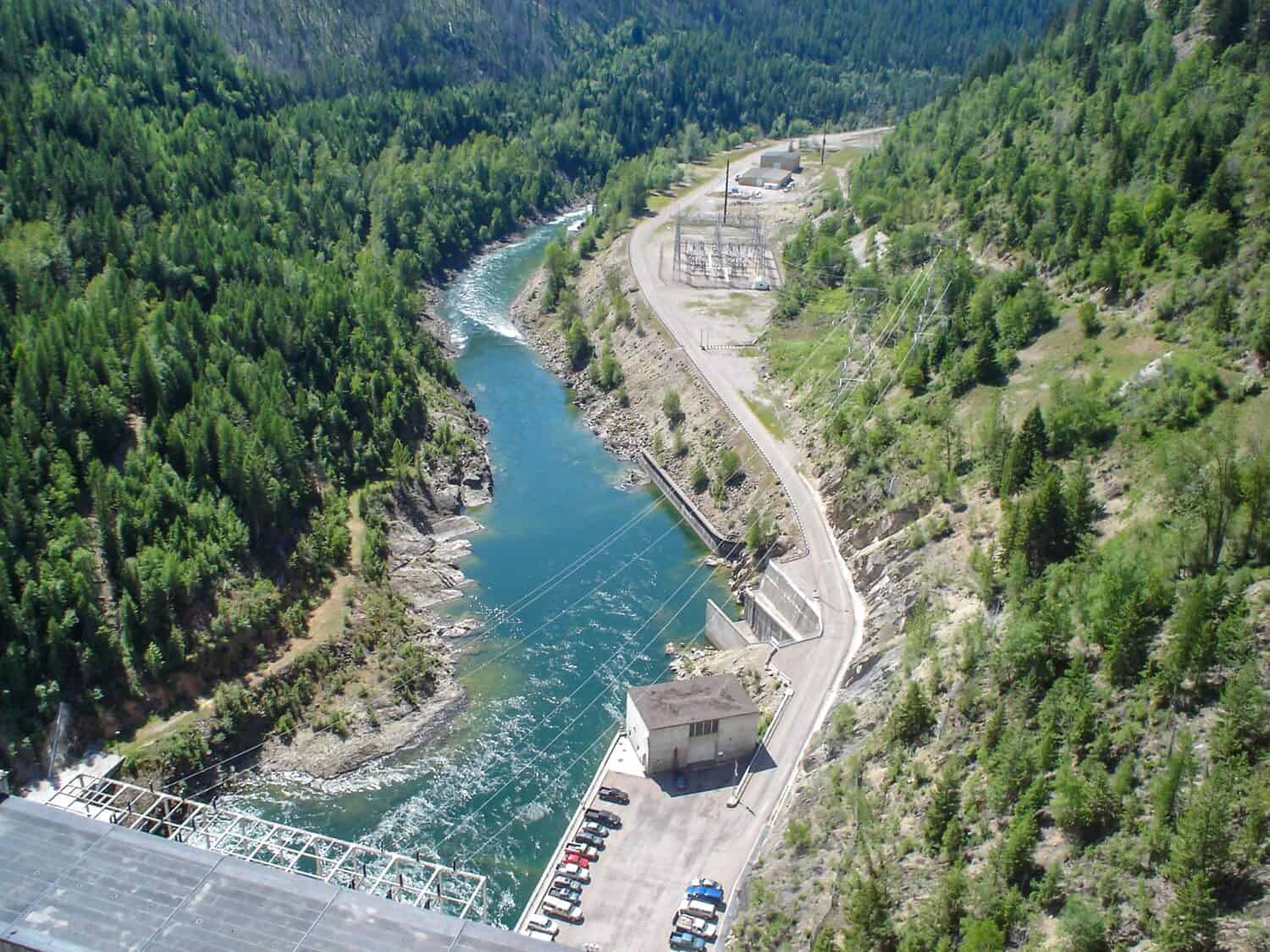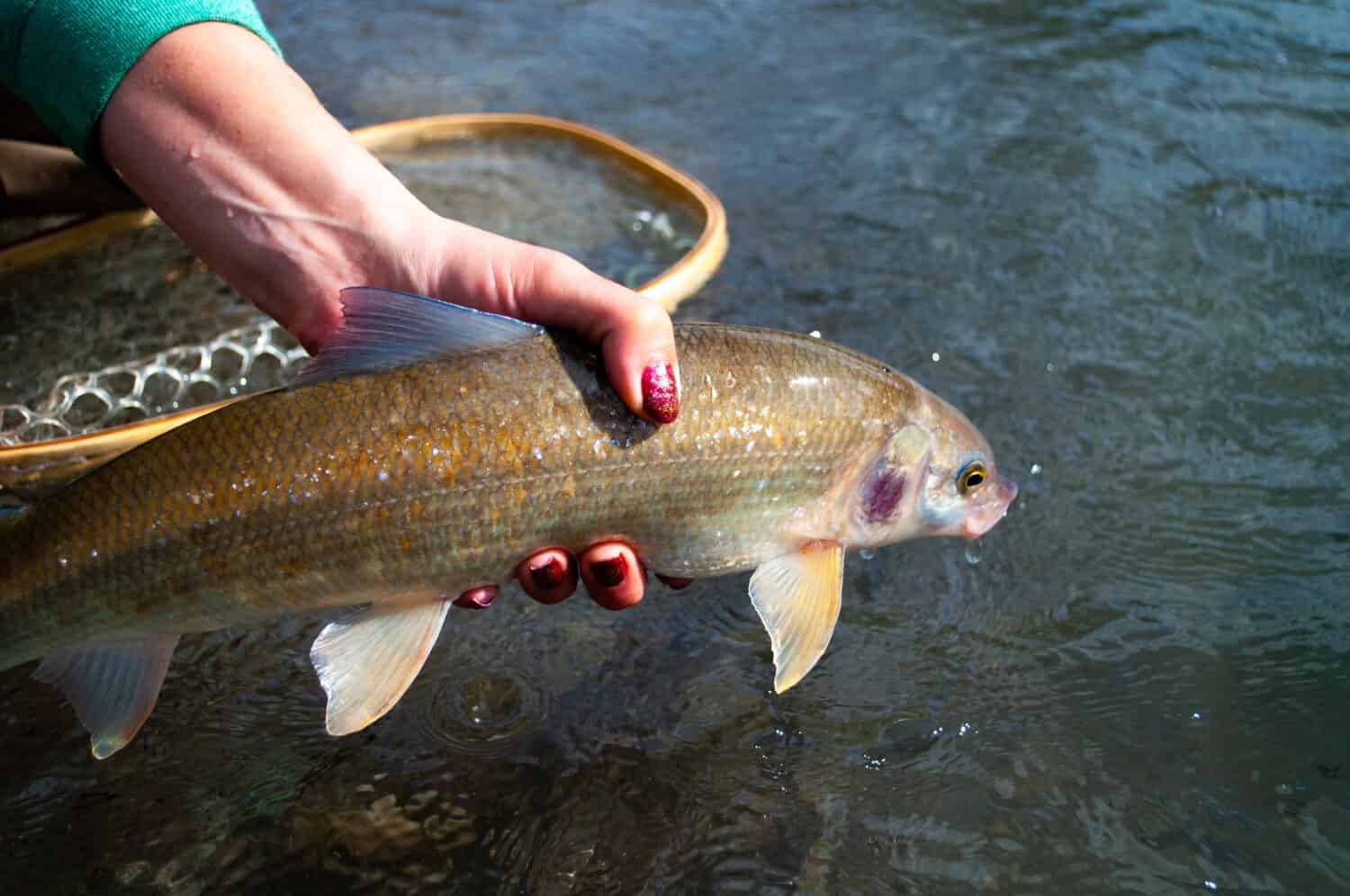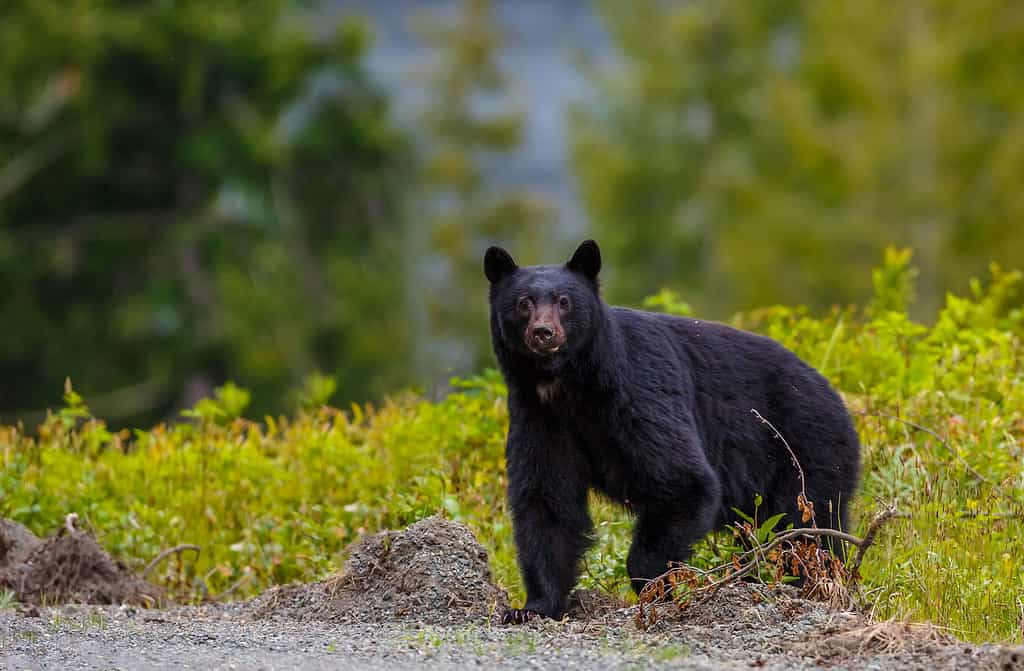Key Points:
- Situated in Montana’s Rocky Mountains, the Hungry Horse Dam is 564 feet high and 2,100 feet long.
- The dam cost about $100 million to construct and produces approximately $57.7 million worth of energy a year.
- Its name comes from the local legend of two escaped freight horses, who were found almost starved to death along South Fork Flathead River in 1900-1901 and nicknamed the “Mighty Hungry Horses.”
Dams are fantastic inventions, allowing us to control where the water goes and when. Many states in the United States use dams to store water in reservoirs for homes and industries. The water is also used for irrigation or to produce electricity, just like the highest dam in Montana. Find out more about the benefits of this towering behemoth!

Where Is the Highest Dam in Montana?

The highest dam in Montana is 564 feet high and 2,100 feet long.
©Mihai N/Shutterstock.com
Looming at an impressive 564-foot height, the Hungry Horse Dam sits across the South Fork Flathead River. It is located in the northwest of Montana.
The dam is 2,100 feet long and has over 2 million cubic yards of concrete. It cost about $100 million to construct. However, the money the Hungry Horse Dam produces from selling electric power from its four generators rapidly recoups the cost. The dam produces approximately $57.7 million worth of energy a year.
The Hungry Horse Dam keeps the Flathead River from flooding into the valley. The flood damage prevented in the Flathead Valley alone has saved over a million dollars annually.
Where Is Hungry Horse Dam Located on a Map?
Hungry Horse Dam is situated in Montana’s Rocky Mountains. It is within Flathead National Forest in Flathead County. It’s around 15 miles south of Glacier National Park’s west entrance, 9 miles southeast of Columbia Falls, and about 20 miles northeast of Kalispell. The dam is 44 miles from the Canadian border. The road providing entrance to the dam is in the town of Hungry Horse.
When Was the Hungry Horse Dam Built?
World War II put considerable pressure on the United States to support all manufacturing. One of the resources needed was electricity. Congress approved the Hungry Horse Dam project in 1944, but because war efforts delayed the project, construction didn’t begin until 1948. The construction, the dam itself, and the subsequent power plant are all operated by the US Bureau of Reclamation.
Completed in July 1953, the Hungry Horse Dam controls flooding and produces hydroelectric power. By law, the Hungry Horse Dam can also be used for irrigation; however, irrigation systems have yet to be built. So, its primary purpose is for flood control and producing power.
In November 1953, contractors also built a road across the highest dam in Montana. Besides being a practical route for residents, driving or walking across one of America’s largest concrete arch dams is also an adventure. At 564 feet high, the Hungry Horse Dam is an impressive structure to cross.
Where Did the Highest Dam in Montana Get Its Name?

The dam’s name comes from the story of two freight horses nicknamed “Mighty Hungry Horses.”
©Mihai N/Shutterstock.com
It comes from a local legend of two freight horses who escaped during the horrible winter of 1900-1901. Struggling for a month in the belly-deep snow, locals discovered these two horses almost starved to death in the snow along South Fork Flathead River. It took considerable effort to bring them back to health, and the astonished loggers who found the horses nicknamed them the “Mighty Hungry Horses.” People even named the area’s mountain, lake, and creek “Hungry Horse.”
Both the dam and the unincorporated community where the dam is located get their names from this legend. The dam’s community sprang up during the construction of the dam. The project team built temporary housing for the workers as they took on this massive project. A community formed during the five-year construction of the Hungry Horse Dam. In 1948, they officially changed the name of “Damtown” to “Hungry Horse.”
Wildlife Around the Hungry Horse Dam
Because of the South Fork of the Flathead River, the surrounding forest, and only being 15 miles of Glacier National Park, you can spot some incredible wildlife around the Hungry Horse. Many species of animals thrive in the fresh, mountainous area surrounding the Hungry Horse Dam.
Mountain Whitefish

Mountain whitefish are demersal feeders, meaning they feed from the bottom of the stream or lake.
©Jennifer de Graaf/Shutterstock.com
The mountain whitefish grows to be 10-16 inches long with a weight of up to 5 pounds. It’s a skinny, silver fish that resembles an Arctic grayling. They like cold mountain streams, lakes, or clear reservoirs. It’s a demersal feeder, meaning it feeds from the bottom of the stream or lake. A mountain whitefish will stir up the sediment with its bottom fins, exposing insect larvae, crayfish, or snails that it gobbles up.
A mountain whitefish develops fully by three years of age. A female lays up to 4,000 eggs annually. In the fall, when they spawn, mountain whitefish seek out gravel bars with a water depth of 30 inches. The eggs settle between the rocks and develop until they hatch in early March.
Common Goldeneye

Common goldeneye (
Bucephala clangula) can be found in Flathead River by Montana’s highest dam.
©iStock.com/Jeff Kingma
The common goldeneye is medium in size but with a large head. It has a small and narrow bill, compared to other ducks, which is helpful when it is foraging underwater for food. Its diet includes small marine worms, insects, crayfish, leeches, and small fish.
Males have distinguished green heads with an iridescent quality, while females have muted brown heads. Both genders have black and white bodies with a white spot near the bill. They also have dazzling golden-colored eyes, which is how this duck got its name.
The common goldeneye is a fast flier. You may catch a “whistling” sound from their fast wings. This is why the common goldeneye also received the nickname “whistler.”
While lake acidification affects many types of animals, the common goldeneye is one of the few that benefit in the short term. They aren’t as sensitive to acidification like many fish are. As the fish population decreases, this means less competition for the goldeneyes who feast on the acid-tolerant insects.
Black Bears

Black bears have long claws that can grow 2-3 inches on average.
©Menno Schaefer/Shutterstock.com
As fantastic swimmers, black bears can cover over 1.5 miles in the water. Black bears are also excellent climbers, and their long claws, which can grow 2-3 inches on average, help them climb. In addition, they use these massive claws to tear apart rotten logs or stumps for tasty insects.
At birth, black bears weigh less than a pound! By the time they are three months old, they are 20-30 pounds, which is an impressive growth spurt. Once an adult, a female black bear can weigh 180 pounds, and a male can weigh 660 pounds.
When it comes to food, black bears aren’t picky. Over the summer and fall, they will feast upon berries, roots, salmon, deer, or leftover prey from other predators. They are on a mission to store up enough fat for hibernation.
What Would Happen If the Hungry Horse Dam Ever Broke?
The Hungry Horse Dam is a crucial structure for preventing flooding. Currently, about 3.086 million acre-feet of water sit in the reservoir, according to James Dean, regional emergency management coordinator for the Bureau of Reclamation. One acre-foot measures one foot of water that spreads over one acre.
Towns beneath the dam, like Hungry Horse and Columbia Falls, would be utterly demolished. Many in the Pacific Northwest who depend on the power generated by Montana’s highest dam would be affected for weeks or more. Animals would be killed, and Flathead River and other water sources beneath the dam would be polluted from the towns’ wreckage. In short, the area would be devastated.
Luckily, there is a small chance of that happening. Hungry Horse Dam performed well in all of the earthquake tests, and between 1920-1960, a 6.0 magnitude earthquake hit across western Montana at least once a decade, and the Hungry Horse Dam didn’t sustain any damage during those times.
Safe and sturdy, the Hungry Horse Dam has faithfully provided electricity and controlled flooding since 1953. Thankfully, the highest dam in Montana is a secure structure, and the odds of it failing from a natural disaster are slim.
The photo featured at the top of this post is © Mihai N/Shutterstock.com
Thank you for reading! Have some feedback for us? Contact the AZ Animals editorial team.







